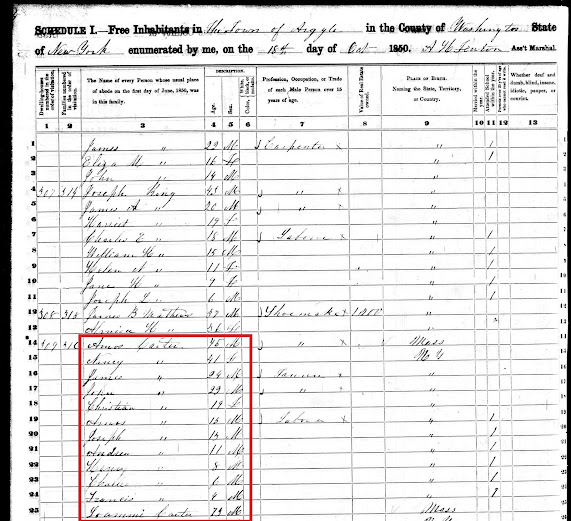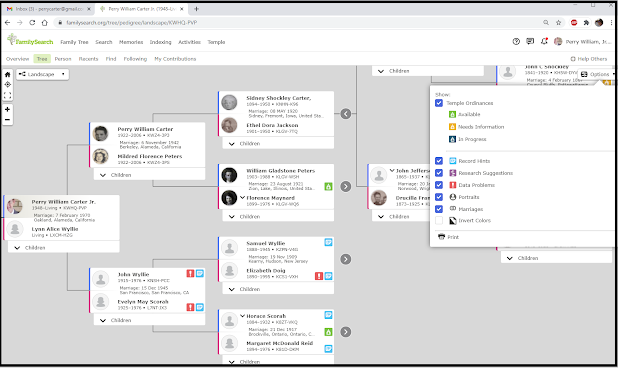Temple and Family History Lesson 10: Descendancy Research
Temple and Family
History
Lesson 10
Descendancy
Research
In our last lesson we looked at how to find and submit
ordinances for temple work. In that
lesson we introduced the concept of Descendancy Research. In this lesson we will look more closely at
this activity and how to apply it to bless thousands of our relatives with
ordinances of salvation.
There are still members of the church who, when asked if
they would like help with their family history work, will say that their work
is “all done”. I’m not sure what the
expression “all done” really means and I’m sure the members who uses those
words to describe their family-history status don’t know either.
It is plainly impossible, even with today’s unprecedented
information availability, for all of the temple ordinances for all of one’s
relatives back to Adam to be “all done”.
What the expression usually means is that all of the obvious, easy to
find, direct ancestors and some of their families back maybe 300 years have had
their temple ordinances completed. That
would be an amazing accomplishment but it may be possible.
Years ago the church instructed us to see that the work was
done for four generations of our ancestors, meaning our parent’s family in
which we are a child, our grandparents families, in which our parents were
children, our great grandparent’s families in which our grandparents were
children, and our great-great grandparent’s families. In each generation we were to see to the temple
ordinances for our direct-line ancestors and their immediate siblings
only.
Then about 15 years ago, and my memory is not too good on
this time frame, the Brethren asked us to expand our efforts to include all of the
descendants of all the persons include in the above-mentioned families. This new effort was called “Descendancy
Research”, and it enlarged all of our research horizons substantially.
I mentioned in the last lesson that I once created a
spreadsheet to calculate an estimated number of relatives one could have
assuming certain conditions of procreation.
My reason for doing this was to emphasize the basis for Descendancy
Research. We have millions more aunts,
uncles, and cousins than we do direct ancestors, giving us much more research
space than if we are just looking for direct line families.
The numbers go something like this. If we assume that each of our direct ancestral couples had three offspring that reached maturity and had three offspring of their own and that this fertility rate continued constant down to the present generation; and if we also assume that there were no instances of cousins marrying cousins at any generation level, or pairs of sisters marrying pairs of brothers, because these situations eliminate one or more sets of grandparents, and if we further assume that each generation is 25 years long, then the following results follow.
If we go back 10 generations, and starting our count in the
year 2021, and counting ourselves as the first generation, that takes us back to
the year 1771 with 512 ancestral couples in that year.
Given these assumptions the number of relatives we have
today would be 48,372,941. This is the number of direct ancestors, their three
married children, and all of the descendants of those children counting at the continuous
reproduction rate of three per family. The thought of identifying that many persons
is, of course, overwhelming, and these conditions are conservative!
But we mustn’t forget that we cannot submit ordinances for
persons born within the last 110 years unless we are the closest living
relative, which is not likely to be the case as we have mentioned before. If we stop our count of relatives at the
generation just before 1911 (110 years ago), we have only 1,790,000 relatives
to be responsible for, a much more manageable number! It is also a certainty that there are many
other members of the church with these same relatives, so we are not alone with
this task. We can see from these numbers
that it is quite impossible for anyone’s work to be “all done”.
With that introduction to the exciting possibilities of
Descendancy Research, let’s take a look at how to start.
Records that Reveal Families
One of the best sources of genealogical information tying
families together is the census. Many
countries started taking a national census with names of all family members
shortly after the 1836 visit of the Prophet Elijah who restored the keys and
power for sealing families together. In
the USA that first census was in 1850. The
earlier censuses, starting in 1790, enumerated only the heads of households by
name, followed by a count of persons corresponding to 5-year ranges of age. These are helpful censuses but hardly
decisive in establishing family units.
Figure 1 is a valuable example of a census entry from 1850,
the first year that names of wives and children were included. It is the record of my third great
grandfather Amos Carter and his wife, Nancy, who were living in upstate New York
in that year with their 9 children. We
would not know the names of these children if it were not for this census
record.
Figure 1. 1850 Census of Argyle, New York. Family of Amos Carter
Other records that often reveal the names of siblings in a
family are obituaries, which typically list the names of both surviving and
predeceased siblings, and, where a family remains in one location for many
years, birth records may record the births of several children to the same
parents, usually one birth about every two years.
Under the premises of Descendancy Research I can now not
only submit ordinance requests for Amos’s nine children, but also for all of
the descendants of these children down to the last generation born before 1911. Fortunately there are others also working on
this family.
The Descendancy Tree
Family Search offers a quick way to see which of all of Amos
Carter’s descendants are currently included in the data base. This tool is called the Descendancy Tree.
The Descendancy tree is reached from the Person Page by first clicking on the “View Tree” link at the upper right corner of the page as indicated in Figure 2.
Figure 2. The “View Tree” link on the Person Page opens the tree menu for the person.
That link will open the Tree Menu as shown in Figure 3. The bottom selection in the Tree Menu is “Descendancy”
and, clicking on that link opens the Descendancy Tree a portion of which is also shown in Figure 3.
This screen, the “Descendancy” tree, not only shows all of
the recorded descendants of Amos Carter, but also their ordinance status as
indicated by the colored tiles to the right of each name. Notice that on this tree, which shows only
the first 10 of 87 descendants that are recorded in Family Search for Amos
Carter, three have ordinances that can be requested. In this case there are many more available
ordinances showing as you scroll down through the tree. As we mentioned in the previous lesson this optional
form of the tree diagram is a valuable tool for finding ordinances that can be
requested.
Notice that for each name that has a spouse or children
attached there is a small arrow shown (> or ˅). Clicking on this arrow will either open more
of the person’s family or close them.
Clearly there are many other members of the church who are
descendants of Amos Carter, because neither I nor any of my siblings submitted most
of the 87 names on this tree.
By clicking on any name on this tree you can go to the
Person Page for that person, and from there you can pursue research on that
person, and their siblings, as discussed in Lesson 8.
What we have introduced in this lesson is the notion that we
can seek out all of the descendants of all the children of all our direct-line
families. The research to uncover the
vital facts for these relatives will be the same as presented previously, as
will be the process of requesting and submitting ordinances for these people as
discussed in Lesson 9. The message for
us in this is that when we run into a difficult research problem with one
individual, we can pick up the trail for one of his or her siblings and try to
work that line for a while, maybe finding some hints that will take us back to
the difficult brother or sister. Descendancy Research opens thousands more names that we can now seek out and submit ordinances for.
In our next lesson we will look at the ubiquitous problem of
finding and correcting errors in Family Search facts.





Comments
Post a Comment